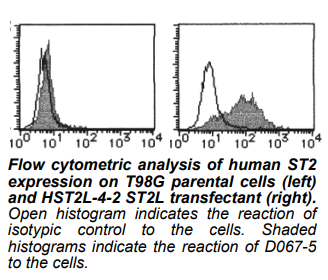Anti-ST2 (Human) mAb-PE
| Code | Size | Price |
|---|
| MBL-D067-5 | 1 mL (50 Tests) | £323.00 |
Quantity:
Prices exclude any Taxes / VAT
Overview
Host Type: Mouse
Antibody Isotype: IgG1
Antibody Clonality: Monoclonal
Antibody Clone: 2A5
Regulatory Status: RUO
Target Species: Human
Applications:
- Flow Cytometry
- Immunoprecipitation (IP)
- Western Blot (WB)
Shipping:
4°C
Storage:
4°C
Images
Documents
Further Information
Applications:
It is reported that this monoclonal antibody can be used in Western blotting and Immunoprecipitation in the reference number 5. FCM - 20 uL
Background:
The ST2 gene, also known as T1, Fit1,
or DER4, was originally identified as a responsive gene that
was highly induced by stimulation of various
proliferation-inducing agents including serum, PDGF
(platelet-derived growth factor), FGF (fibroblast growth
factor), or lysophosphatidic acid in murine fibroblasts.
Three distinct forms of gene products have been reported
and named ST2, ST2V, and ST2L.
ST2 is a soluble secreted form of 37 kDa protein, which
lacks intracellular domain, whereas ST2L is a
transmembrane form of 62 kDa protein (the glycosylated
forms of ST2 and ST2L are about 57 and 80 kDa,
respectively). This ST2L protein is very similar to IL-1R
(interleukin-1 receptor) type I and II in structure, thus it is
considered as a member of the IL-1R family. ST2V, which
is another novel variant form of human ST2, has been
identified recently.
ST2 proteins are expressed in the wide variety types of
human cells, including hematopoietic cells in various stages
of differentiation, a population of the peripheral blood
mononuclear cells from healthy individuals, glioblastoma
and astrocytoma cell lines, and colon cancer cells in
addition to fibroblast cell lines. Thus ST2 proteins are
considered to have some roles in regulating cell growth or
proliferation. On the other hand, either definitive functions
of ST2 proteins or their ligand molecule(s) which binds to
ST2 proteins have remained unclear, though it has been
reported that none of IL-1α, β, RA (receptor antagonist)
binds to ST2 proteins in spite of their structural similarity
to IL-1R. This indicates that ST2L protein is functionally
independent from IL-1R. Furthermore, several studies have
shown that ST2L is expressed on the cell surface of Th2
cells but not on the Th1 cells, indicating the possibility that
ST2L protein participates not only in the regulation of cell
growth or proliferation, but also in the immune system
including differentiation of T cells or immunological
response via helper T cells.
From these observations, ST2 proteins are considered to
be one of the important proteins participate in various
physiological phenomenon, thus further analysis are
required to understand its physiological functions.
Conjugate:
PE
Formulation:
50 tests in 1 mL volume of PBS containing 1% BSA and 0.09% NaN3.*Azide may react with copper or lead in plumbing system to formexplosive metal azides. Therefore, always flush plenty of waterwhen disposing materials containing azide into drain.
Gene IDs:
Human: 6761 Mouse: 17082
Immunogen Translated:
ST2 secreted form was purified from the culture supernatant of COS7 cell transfectants
Reactivity:
This antibody reacts with human ST2 on
Flow cytometry.
Shelf Life:
1 year
Source:
This antibody was purified from mouse ascites
fluid using protein A agarose. This hybridoma (clone 2A5)
was established by fusion of mouse myeloma cell PAI with
Balb/c mouse splenocyte immunized with secreted form of
ST2 protein which were purified from culture supernatant
of COS7 transfectant cells.
Target:
ST2
References
1) Shimizu, M., et al., Hum. Mol. Genet. 14, 2919-2927 (2005)
2) Tajima, S., et al., Chest 124, 1206-1214 (2003)
3) Haga, Y., et al., Eur. J. Biochem. 270, 163-170 (2003)
4) Oshikawa, K., et al., Am. J. Respir. Crit. Care Med.164, 277-281 (2001)
5) Kuroiwa, K., et al., Hybridoma 19, 151-159 (2000)
6) Tominaga, S., et al., BBRC 264, 14-18 (1999)
7) L?hning, M., et al., PNAS 95, 6930-6935 (1998)
8) Yanagisawa, K., et al., J. Biochem. 121, 95-103 (1997)
9) Yanagisawa, K., et al., FEBS Lett. 318, 83-87 (1993)
10) Lanahan, A., et al., Mol. Cell. Biol.12, 3919-3929 (1992)
11) Tominaga, S., et al., FEBS Lett. 258, 301-304 (1989)
Clone 2A5 is used in reference number 1) - 5).



